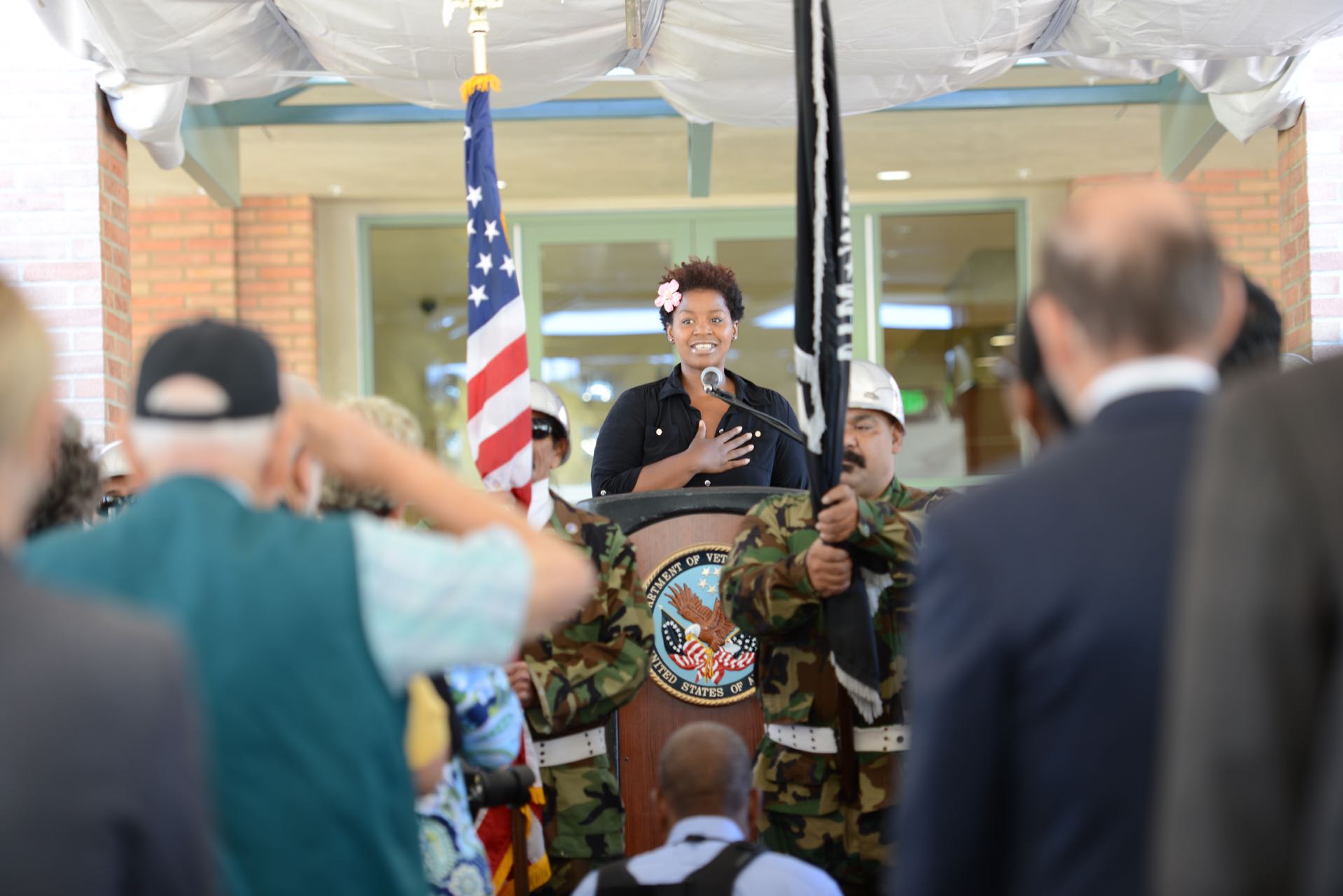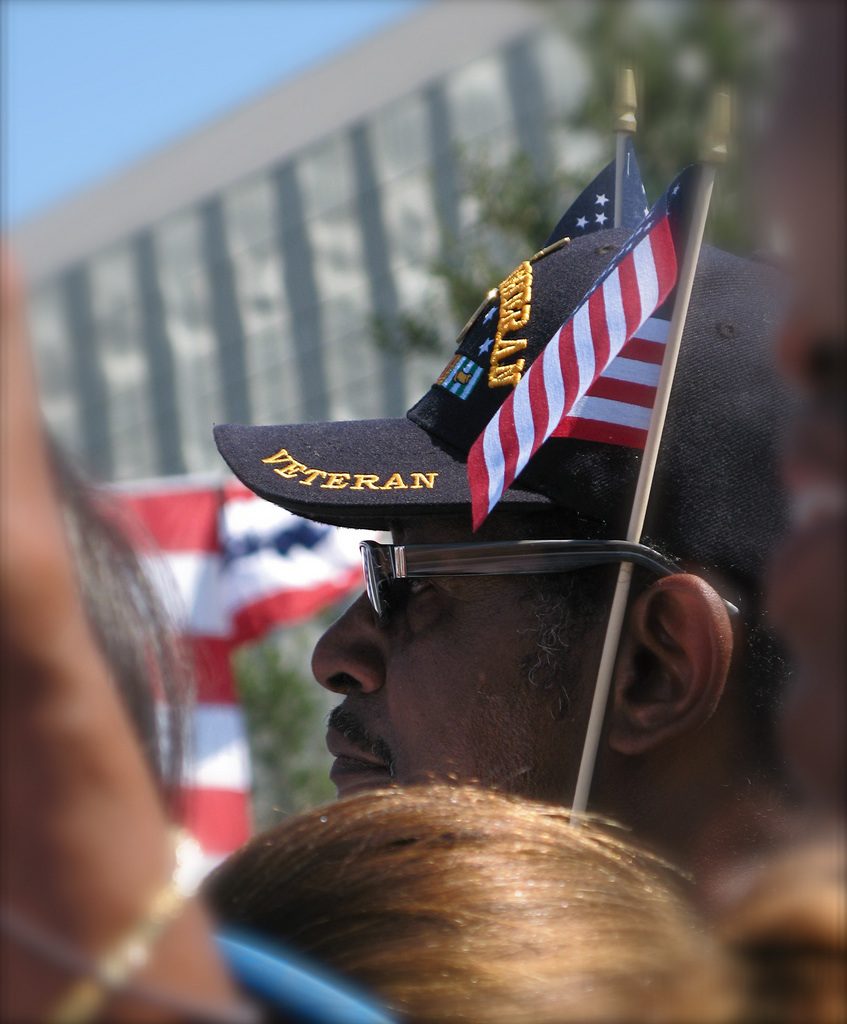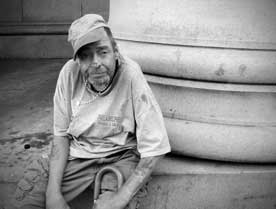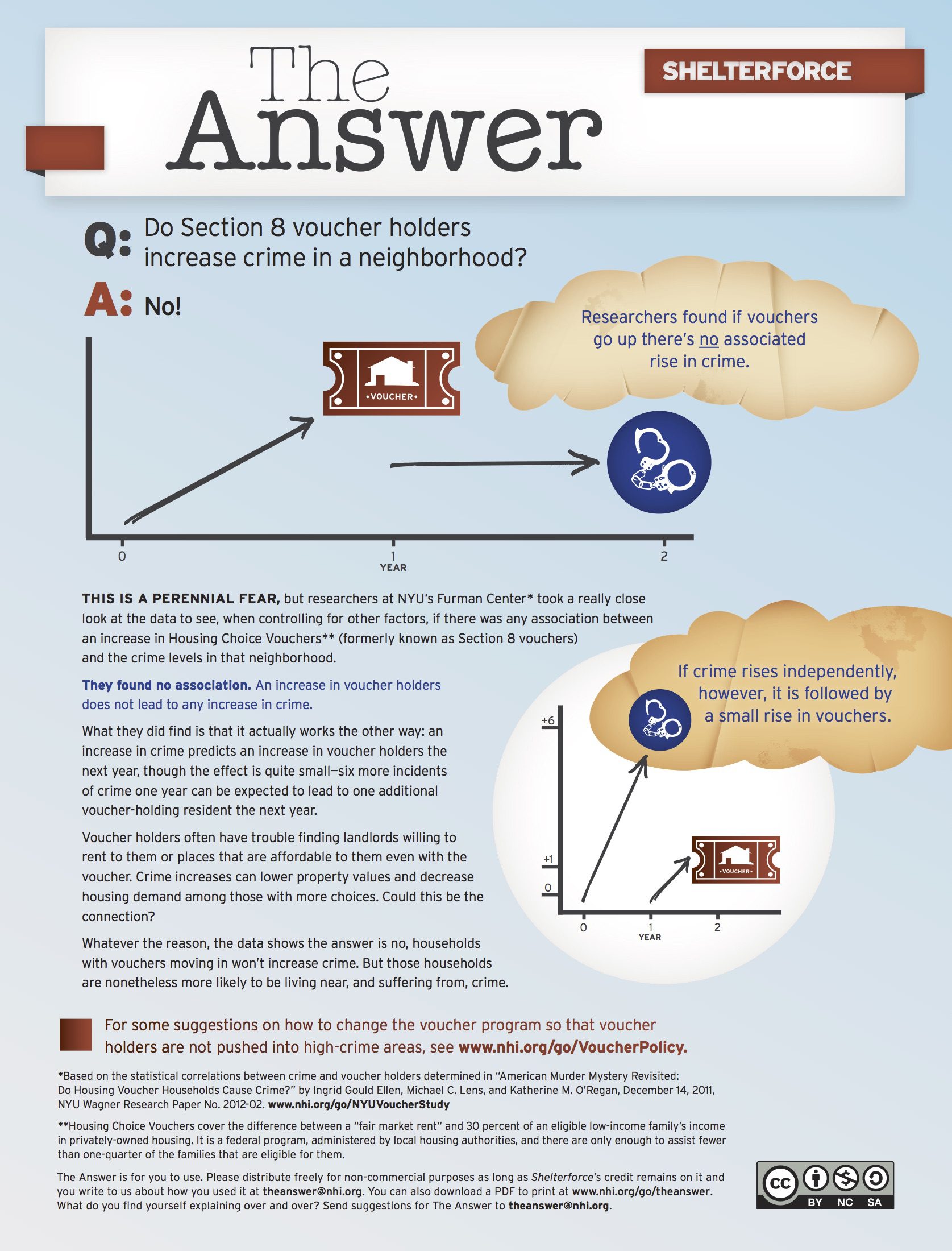
U.S. Military veteran, Lola Parker, during the pledge of allegiance at the opening of New Directions Sepulveda, their first permanent supportive development project in partnership with A Community of Friends and the Greater Los Angeles Veterans Affairs. Photo courtesy of New Directions for Veterans
Stand Down events are days-long gatherings for homeless military veterans and their families. Thousands come to receive assistance from service providers with getting into recovery programs, legal issues, employment, health services, reconnecting with the veteran community, and, ultimately, getting off the streets.
Rick Ochocki is development manager at Veterans Village San Diego (VVSD), an advocacy organization that runs addiction treatment centers in the city and helped place over 400 veterans in permanent housing in 2013. He has been attending Stand Downs for the past several years and recalls noticing a change at the last Stand Down event he attended.
“I remarked to a colleague that I’d never seen so many women before,” he says.
The number of women in active duty has risen over the past two decades to just over 14 percent of the entire military, and women make up 8 percent of the total veteran population. According to the U.S. Government Accountability Office, the number of homeless women veterans more than doubled from 2006 to 2010, from 1,380 to 3,328. The U.S. Dept. of Housing and Urban Development’s (HUD) January 2013 Point-in-Time (PIT) estimate of homeless female veterans was up to 4,456.
As the federal government enters the final phase of a five-year push to end veteran homelessness, local community organizations acknowledge that dealing with the issue does not come with a one-size-fits-all remedy. The causes of veteran homelessness and chronic poverty are very often different for women and men. “Our outreach was single person–focused and male-focused,” says Ochocki of VVSD. “When a woman is homeless, it tends to be a family issue.”
Pillar to Post
Gwendolyn Farris left the Army in 2007 and for two and a half years struggled to find stable employment in her home state of Georgia. “I was doing what is normally called ‘pillar to posting,’ meaning moving from place to place for very short intervals,” she recalls. A single mother, Farris says she never self-identified as a veteran, and was unaware of housing programs available to vets until in 2008, she met another veteran who told her about the HUD-VASH Section 8 voucher. “He assured me that I wouldn’t have to go through the experience that most citizens endure through the normal application procedures,” she says.
But even with the support of the VA, housing placement was not immediate. Farris recalls that while awaiting the voucher, she and her son lived in a host of decrepit situations, including basement rooms that flooded, rooms that were roach and vermin infested, and on the floor in other people’s homes where most of the time, “We were not welcome.” Farris says she and her son lived solely on the child support payments she received—approximately $200 a month, which went largely toward rent in those substandard places.
The situation began to affect Farris’s son, who at the time was nine years old.
“I asked the mother of one of my son’s classmates to take him into her home for two weeks so he could get to and from school,” she says. “I had no place to live and didn’t ask if I could accompany my son. I lived in the Atlanta airport for two and a half weeks, sleeping in hideaway corners.” Farris says she chose the airport because it was clean, safe, and provided easy access to public transit. She showered in public gyms and ate at a local women’s day shelter.
Eventually, the VA invited Farris to enroll in its Compensated Work Therapy program, where she was assigned a social worker and given the opportunity to move into a local Salvation Army shelter with her son. As she started work, Farris received the housing voucher and was given four months to find a home. She’s been in her home since July 2010.
A victim of military sexual trauma (MST), Farris is currently a patient at the VA, where she was diagnosed with and receives treatment for PTSD, depression, and anxiety. She reflects back on the difference housing has made.
The shelter “provided me and my son with a place to sleep,” says Farris. “Being in this home provided us with the comfort and security of knowing we were in our own place where we controlled our living situation. For my son, it means having his own room, his own TV, his own computer. It means getting up for school and going to the bus stop and look[ing] at his home from that vantage point. It gives me pleasure to pay rent and utility bills. I love cooking in my own kitchen on a stove that I don’t have to ask for permission to use. I enjoy watching my son sleep in his bed, even at 16, knowing that one time he had to live in some of the most horrible conditions. I absolutely love my home and am so grateful.”
Farris is now an entrepreneur and works from her home workshop where she sews. She says her goal is to be out of the HUD-VASH program in 2015, her fifth-year anniversary in the program.
A New Face of Veteran Homelessness
Popular culture has painted a picture of the “homeless vet,” as one who is almost always male, a veteran of the Vietnam War, and a drug or alcohol abuser. This image, while always over generalized, is becoming less and less accurate as the demographics of the military change.
Women also face special challenges when their military service ends and they reenter civilian life. According to a 2010 study of the health effects of military service on women published by the Journal of Health Care for the Poor and Underserved, several factors have been found to be associated with the experience of homelessness among women veterans, including: unemployment, disability, post-traumatic stress disorders, anxiety disorders, and history of sexual assault during military service.
And like their civilian counterparts, female military veterans typically serve as the primary caretakers in households, which not only includes children, but other dependent relatives such as aging parents and family members with disabilities. This role can mean they are more likely to delay seeking, or never seek, treatment for personal issues that can ultimately lead to dysfunction that can impede their stability.
Service providers that have chosen to respond to women vets struggling with housing issues recognize that their housing model needs to be different from its inception.
Jas Boothe, founder and president of Final Salute, a housing and service provider and advocacy organization for women veterans headquartered in Virginia, says there are almost a hundred times as many transitional housing options for male vets as for female vets. “Then they say let’s do co-ed housing—let’s put a handful of women and children next to hundreds of guys! But they were all veterans so they can get along.” She makes an incredulous noise. “Those weren’t the guys I served with.”
When designing housing for women vets, “It’s all about safety,” says Joan Sisco, founder and CEO of the outreach and advocacy organization Veterans First Ltd. in Phoenix, Ariz. “And having their own apartment and community areas in which to have conversations with other women veterans.”
Veterans First opened Mary Ellen’s Place, 15 furnished affordable studio apartments specifically designed for women veterans, in 2011. The development is named for a Navy veteran who served in the 1950s, then worked throughout her lifetime in community service to bring recognition to women veterans. With no limit on age or length of tenancy, Mary Ellen’s Place sees itself as a bulwark against veteran homelessness in the form of an affordable, safe, stable environment that enables women vets to gradually reintegrate back into civilian life. The stories of residents range from simply falling on hard times after a job loss to drug addiction to traumatic brain injury resulting from an IED explosion.
“It is our mission to serve our women veterans with advocacy, compassion, respect, and programs and services while providing information and resources to all veterans, their families, and caregivers,” says Sisco. Veterans First is in the midst of a fundraising campaign for its next project, Sallie’s Place, which is slated to open in 2015 and will feature eight furnished two-bedroom units for women veterans and their children.
VVSD has been trying to diversify its offerings to reach more women, but that will require diversifying funding sources as well. VVSD’s Welcome Home Family program features a transitional, sober-living apartment facility for women veterans who have gone through a treatment program and are preparing to be reunited with dependent children. But it’s still being funded on a year-to-year basis, and sometimes VVSD has to dig into reserves or depend on colleagues to keep it going through funding gaps. “Now, this is an existing program,” says Ochocki. “Imagine one that isn’t fully complete yet.”
It Takes a Community of Partners
A Marine Corps veteran, Sisco cites her dedication to building community collaborations—serving on task forces, veteran-related commissions, and committees—as a key to Veteran First’s success since its founding in 2003. Community partnerships have also been instrumental to New Directions for Veterans in Los Angeles. New Directions president Gregory Scott said they knew the need was there to expand their services and programs offered to women veterans threatened by homelessness, but figuring out how to serve them took time.
“Twenty years after Vietnam, there was a growing need, and while the focus was on male veterans, there were female vets who were homeless too. At that time, female vets did not serve on front lines, but they still served in the military. MST was alive and well then, and women were dealing with the effects of battle, MST, being primary caretakers, [and the fact that it was] harder for female vets to get jobs. They wind up getting into drugs, alcohol, all in a male-dominated environment.”
Scott says most of New Directions’ female veteran clients are referred through the VA, and much has been learned as a result of their supportive work. “The results of assault and harassment can worsen the PTSD that women experience, and many women don’t access their benefits because of their experience in the military—the VA hospital is not a female-friendly place. Many vets also have children and may have lost them in the process. We help them.”
New Directions Oasis for Veteran Women was the first program in the U.S. designed specifically for female veterans dealing with issues of homelessness, drug and alcohol addiction, post-traumatic stress syndrome and other mental health issues. This temporary, emergency transitional housing and treatment program integrates the Seeking Safety model, a trauma treatment initiative first published in 2002 that was designed especially for individuals recovering from trauma and substance abuse.
In 2011, the organization launched its housing stability program in partnership with the VA’s Supportive Services for Veteran Families program (SSVF) and the Los Angeles United Way’s Home for Good initiative. “My philosophy is, if we’re going to help veterans, we have to stop them from being homeless in the first place,” says Scott. The program offers both homelessness prevention and rapid rehousing services for at-risk veteran families. In 2014, the program reported that it helped prevent over 300 families from sinking into homelessness.
From Fanfare to Foreclosure
A native of New York City, Sylvia Allen entered the military in 1980 and served in the Gulf War as a finance specialist. A single mother, Allen retired with an honorable discharge and was given her exit papers. “There’s great fanfare when you enter,” she recalls, “but not when you leave.”
Allen says she could only afford to keep her military health benefits for her son, who was a teenager at the time. She purchased a home in Gwinette County, Ga., where she worked full-time at Wells Fargo bank and consulted on the side as a personal trainer. Allen says many women may feel depressed after they leave the military, with PTSD showing up also. “To transition [into civilian life] is a mental thing more so than a physical thing. Have a therapist,” she advises.
In 2007, the recession hit and Allen lost her job at the bank. She relied on her irregular income as a personal trainer, but went from eight clients and seven classes a week to one client and $400 a month. Through savings and part-time jobs, Allen survived in her home until 2009, but then it was foreclosed upon. Over the next year and a half, with her son away at college, she lived in her truck and then moved to Florida with her mother before returning to Georgia.
It was while staying with a friend and visiting their church that Allen inquired about temporary housing options. She was put in touch with a representative from The United Way, who connected her to a homeless veterans program in Atlanta.
“The VA verified my [military] service, and my rep asked, ‘Where have you been?’” she remembers. Allen admits she had never made a “big deal” of being a veteran, and had been totally unaware that she qualified for benefits, including the medical and dental benefits she now has. She stayed at a shelter for two weeks, and then moved into Mary Hall Freedom House, a VA partner organization in Atlanta. While at Freedom House, Allen began working and was identified as a candidate for the HUD-VASH program. “People see that you are motivated, they want to help you,” she says. She received a voucher for $799 and worked with a real estate agent to find a home she could afford back in Gwinette County. She moved in to her home in April 2011 and has been there since.
Allen is critical of veteran job programs that she’s encountered. She says many of the jobs offered to women vets do not make use of their qualifications. “They were finding us jobs as cleaners. Do you have anything for accountants or in customer service? Women vets want to do better.” Allen still consults as a personal trainer. She says she struggled last year, but is conservative by nature and a saver. She hopes to soon leave the HUD-VASH program and enter a lease-to-own agreement for her home.
“I’ll never be homeless again,” she says.
Recognition and Support
Boothe, of Final Salute, herself a veteran who experienced homelessness, is a strong proponent of the “housing first” model, especially for women veterans. “It’s not a benefits issue—counseling won’t help you not to be homeless, medical care won’t help you if you don’t have anywhere to go,” she argues. Over half of the women Final Salute encounters have children, says Boothe, and so you have to offer services in the right order. “If I can’t afford day care, a job isn’t appealing to me—somewhere safe to put my kids is appealing. Then [I] can work on employment.”
Final Salute operates three transitional homes in safe and thriving residential communities. The residents are given a high degree of privacy and autonomy, but feel part of a unit with common chores and a schedule. “The issue is transitioning to operating as individual. In the military you are part of a team. [So] we put them back into a unit environment. They watch each other’s kids. It’s very therapeutic.”
All Final Salute residents have their own keys to the houses. Booth says they have been criticized for that by people who say, “You don’t really know them,” but she pushes back: “My fourth week of training I was given a fully loaded gun by people who don’t know me. We trust these women with our lives; I don’t think a key is a big deal.”
In the short-term, Boothe hopes that other veteran service providers will do more outreach to women and encourage them to apply. In the long-term, she says, “The solution is more affordable housing for female veterans. Once we’re on the street, it’s too late. They’re sleeping in cars, staying in situations where they are getting beaten because it’s better than the alternative.”
Boothe believes that for women veterans, the problem of homelessness will get worse before it gets better. “With the impending drawdown, [the problem] hasn’t even hit the fan yet.”
“We’ve been serving since the early 1900s,” she says. “Being an afterthought in 2014 is kind of absurd.”




Thank you for this information, I agree totally. We always here about the male veterans and their struggle. I’m not saying that it is not true however, I have not heard anyone mention anything about the women veterans. Why is it so hard for society to comprehend that women are just as important. Furthermore, that is one of the reasons why I stop sending money. I did not believe that any part of my gifts were going towards the women vet. This is serious, and the word needs to get out. Women need to be helping one another out.